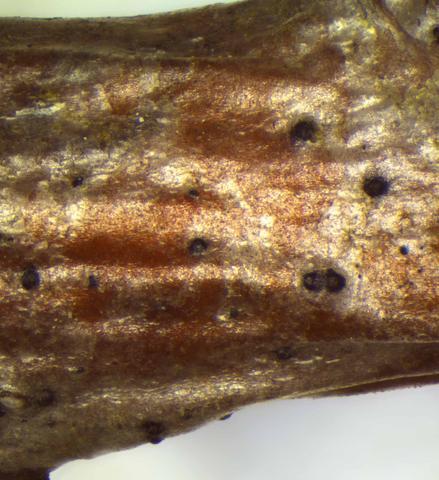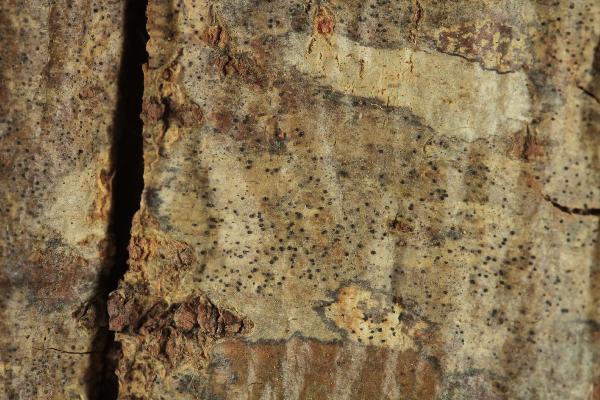Arthopyrenia salicis A. Massal.
Ric. Auton. Lich. Crost.: 169, 1852.
Synonyms: Arthopyrenia persoonii var. alni (A. Massal.) Arnold; Leiophloea salicis (A. Massal.) Trevis.; Pyrenula salicis (A. Massal.) Trevis.
Distribution: N - Ven (Lazzarin 2000b), TAA (Hinteregger 1994), Piem (Matteucci & al. 2010, Ravera & al. 2016b), Lig (Brunialti & al. 2001, Burguera & al. 2024). C - Tosc, Marc (Frati & Brunialti 2006), Umb (Ravera 1998, Ravera & al. 2006 Ravera & al. 2016b), Laz (Ravera & al. 1999, 2000, Munzi & al. 2007, Ravera & Genovesi 2008, Ravera & al. 2016b), Abr (Caporale & Pagliani 2010), Mol (Caporale & al. 2008, Caporale & Ravera 2020). S - Camp (Brunialti & al. 2013, Ravera & Brunialti 2013 Ravera & al. 2016b), Bas (Potenza 2006, Potenza & al. 2010, Potenza & Fascetti 2012 Ravera & al. 2016b), Si (Ravera & al. 2016b).
Description: Thallus crustose, endosubstratic, pale to (rarely) dark brown, poorly evident, facultatively lichenized. Perithecia black, 0.15-0.3 mm across, circular or elliptical in outline, often with a depressed ostiole. Involucrellum dimidiate, brown, K-, of thick-walled hyphae extending into the surrounding bark tissues; exciple colourless throughout; interascal tissue absent or pseudoparaphyses soon gelatinized, but the ostiolar region lined with short, 7-15 x 1-1.5 μm, unbranched periphysoids oriented downwards; hymenial gel sometimes I+ pale blue. Asci 8-spored, obpyriform to saccate, thick-walled and fissitunicate with rostrate dehiscence, 33-45 x 14-20 μm. Ascospores 1-septate, constricted at septum, each cell often biguttulate, the lower cell sometimes with a median constriction, hyaline, biseriately arranged in the asci, (12-)14-17(-21) x 4-5.5 μm, with a very narrow or indistinct gelatinous sheath. Pycnidia rare, black. Conidia 1-celled, narrowly ellipsoid or bacilliform, 3-4 x c. 1 μm. Photobiont absent or trentepohlioid. Spot tests: thallus K-, C-, KC-, P-, UV-. Chemistry: without lichen substances. Note: a temperate coloniser of the smooth bark of deciduous trees and shrubs, especially Carpinus and Corylus, most frequent in upland areas. Thalli vary from having no detectable to abundant Trentepohlia. The species, which was probably mistaken for Naetrocymbe punctiformis and related species in the past, is unrelated to Arthopyrenia s.str. (Thiyagaraja & al. 2021). It is included in the Italian red list of epiphytic lichens as “Near-threatened” (Nascimbene & al. 2013c). See also notes on A. coppinsii and A. tuscanensis.
Growth form: Fungus
Substrata: bark
Reproductive strategy: mainly sexual
Most common in areas with a humid-warm climate (e.g. most of Tyrrenian Italy)
Pioneer species
Commonnes-rarity: (info)
Alpine belt: absent
Subalpine belt: absent
Oromediterranean belt: absent
Montane belt: very rare
Submediterranean belt: extremely rare
Padanian area: absent
Humid submediterranean belt: very rare
Humid mediterranean belt: extremely rare
Dry mediterranean belt: absent

Predictive model
Herbarium samples


Felix Schumm - CC BY-SA 4.0
[20312], Germany, Baden-Württemberg, Kreis Göppingen, Göppingen, im Spitalwald nahe dem Stauferpark, 49,71818° N, 9.68617° E, 342 m. Leg. et det. F. Schumm, 28.03.2019.
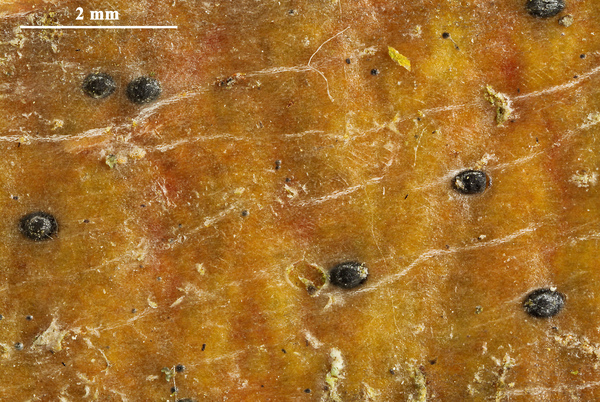

Felix Schumm - CC BY-SA 4.0
[20312], Germany, Baden-Württemberg, Kreis Göppingen, Göppingen, im Spitalwald nahe dem Stauferpark, 49,71818° N, 9.68617° E, 342 m. Leg. et det. F. Schumm, 28.03.2019.
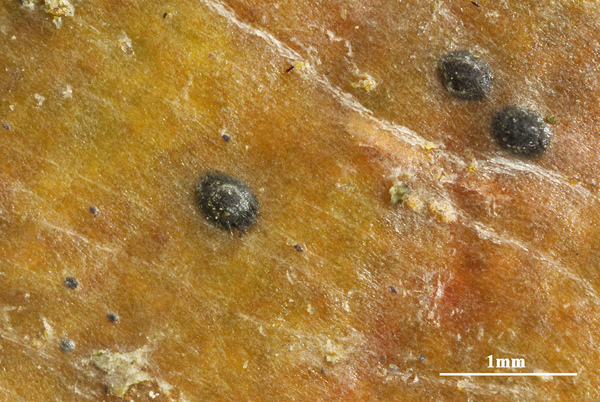

Felix Schumm - CC BY-SA 4.0
[20312], Germany, Baden-Württemberg, Kreis Göppingen, Göppingen, im Spitalwald nahe dem Stauferpark, 49,71818° N, 9.68617° E, 342 m. Leg. et det. F. Schumm, 28.03.2019.


Felix Schumm - CC BY-SA 4.0
[20312], Germany, Baden-Württemberg, Kreis Göppingen, Göppingen, im Spitalwald nahe dem Stauferpark, 49,71818° N, 9.68617° E, 342 m. Leg. et det. F. Schumm, 28.03.2019.


Felix Schumm - CC BY-SA 4.0
[20312], Germany, Baden-Württemberg, Kreis Göppingen, Göppingen, im Spitalwald nahe dem Stauferpark, 49,71818° N, 9.68617° E, 342 m. Leg. et det. F. Schumm, 28.03.2019.
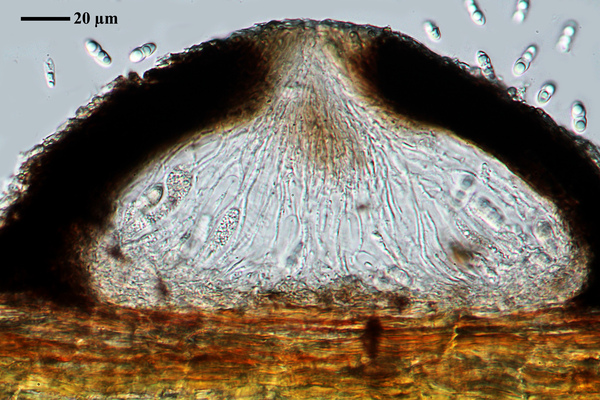

Felix Schumm - CC BY-SA 4.0
[20312], Germany, Baden-Württemberg, Kreis Göppingen, Göppingen, im Spitalwald nahe dem Stauferpark, 49,71818° N, 9.68617° E, 342 m. Leg. et det. F. Schumm, 28.03.2019.


Felix Schumm - CC BY-SA 4.0
[20312], Germany, Baden-Württemberg, Kreis Göppingen, Göppingen, im Spitalwald nahe dem Stauferpark, 49,71818° N, 9.68617° E, 342 m. Leg. et det. F. Schumm, 28.03.2019.
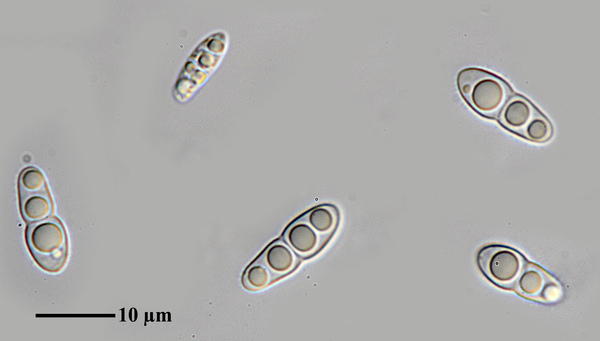

Felix Schumm - CC BY-SA 4.0
[20312], Germany, Baden-Württemberg, Kreis Göppingen, Göppingen, im Spitalwald nahe dem Stauferpark, 49,71818° N, 9.68617° E, 342 m. Leg. et det. F. Schumm, 28.03.2019.
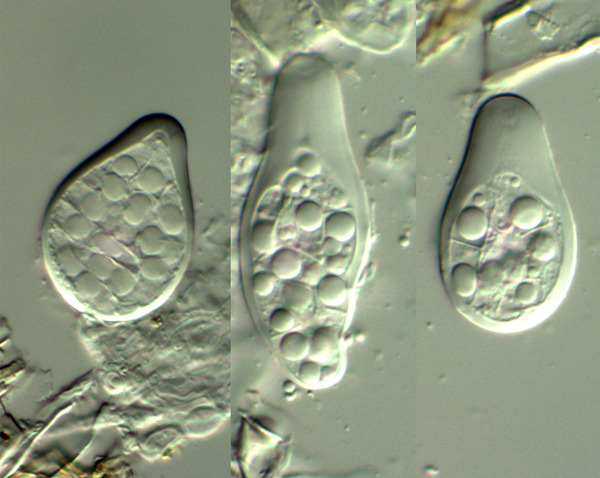
Photo uploaded by P. Cannon - CC BY-SA NC - Source: http://fungi.myspecies.info/sites/fungi.myspecies.info/files/Arthopyrenia%20salicis%201.jpg
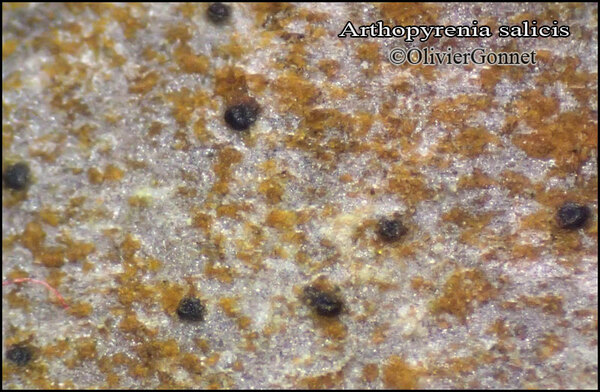
Courtesy Danièle et Olivier Gonnet - Source: https://www.afl-lichenologie.fr/Photos_AFL/Photos_AFL_A/Textes_A3/Arthopyrenia_salicis.htm
France, Sur écorce de Corylus avellana - Combe Lavaux - Côte-d'Or
31/05/2015

Courtesy Danièle et Olivier Gonnet - Source: https://www.afl-lichenologie.fr/Photos_AFL/Photos_AFL_A/Textes_A3/Arthopyrenia_salicis.htm
France, Sur écorce de Corylus avellana - Combe Lavaux - Côte-d'Or
31/05/2015
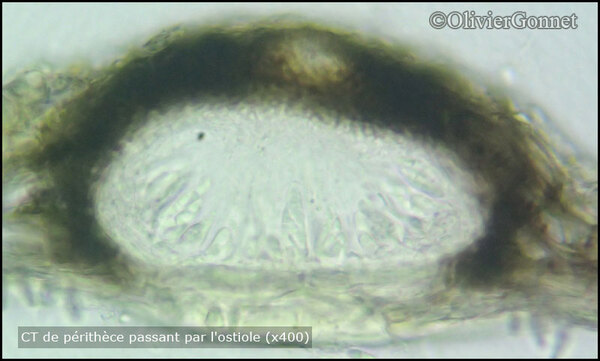
Courtesy Danièle et Olivier Gonnet - Source: https://www.afl-lichenologie.fr/Photos_AFL/Photos_AFL_A/Textes_A3/Arthopyrenia_salicis.htm
France, Sur écorce de Corylus avellana - Combe Lavaux - Côte-d'Or
31/05/2015
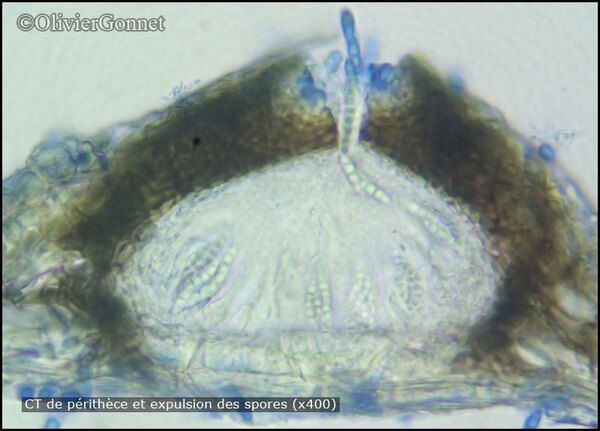
Courtesy Danièle et Olivier Gonnet - Source: https://www.afl-lichenologie.fr/Photos_AFL/Photos_AFL_A/Textes_A3/Arthopyrenia_salicis.htm
France, Sur écorce de Corylus avellana - Combe Lavaux - Côte-d'Or
31/05/2015
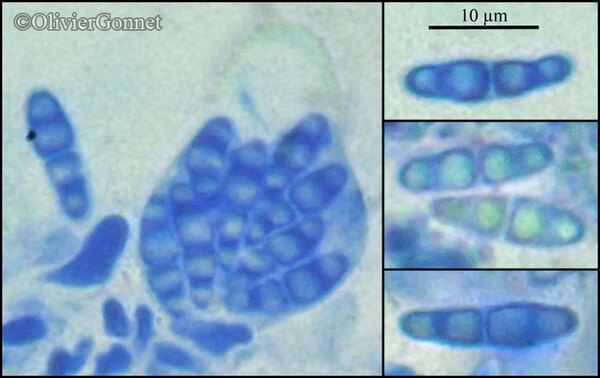
Courtesy Danièle et Olivier Gonnet - Source: https://www.afl-lichenologie.fr/Photos_AFL/Photos_AFL_A/Textes_A3/Arthopyrenia_salicis.htm
France, Sur écorce de Corylus avellana - Combe Lavaux - Côte-d'Or
31/05/2015
Growth form: Fungus
Substrata: bark
Reproductive strategy: mainly sexual
Most common in areas with a humid-warm climate (e.g. most of Tyrrenian Italy)
Pioneer species
Commonnes-rarity: (info)
Alpine belt: absent
Subalpine belt: absent
Oromediterranean belt: absent
Montane belt: very rare
Submediterranean belt: extremely rare
Padanian area: absent
Humid submediterranean belt: very rare
Humid mediterranean belt: extremely rare
Dry mediterranean belt: absent

Predictive model
| Herbarium samples |


Felix Schumm - CC BY-SA 4.0
[20312], Germany, Baden-Württemberg, Kreis Göppingen, Göppingen, im Spitalwald nahe dem Stauferpark, 49,71818° N, 9.68617° E, 342 m. Leg. et det. F. Schumm, 28.03.2019.


Felix Schumm - CC BY-SA 4.0
[20312], Germany, Baden-Württemberg, Kreis Göppingen, Göppingen, im Spitalwald nahe dem Stauferpark, 49,71818° N, 9.68617° E, 342 m. Leg. et det. F. Schumm, 28.03.2019.


Felix Schumm - CC BY-SA 4.0
[20312], Germany, Baden-Württemberg, Kreis Göppingen, Göppingen, im Spitalwald nahe dem Stauferpark, 49,71818° N, 9.68617° E, 342 m. Leg. et det. F. Schumm, 28.03.2019.


Felix Schumm - CC BY-SA 4.0
[20312], Germany, Baden-Württemberg, Kreis Göppingen, Göppingen, im Spitalwald nahe dem Stauferpark, 49,71818° N, 9.68617° E, 342 m. Leg. et det. F. Schumm, 28.03.2019.


Felix Schumm - CC BY-SA 4.0
[20312], Germany, Baden-Württemberg, Kreis Göppingen, Göppingen, im Spitalwald nahe dem Stauferpark, 49,71818° N, 9.68617° E, 342 m. Leg. et det. F. Schumm, 28.03.2019.


Felix Schumm - CC BY-SA 4.0
[20312], Germany, Baden-Württemberg, Kreis Göppingen, Göppingen, im Spitalwald nahe dem Stauferpark, 49,71818° N, 9.68617° E, 342 m. Leg. et det. F. Schumm, 28.03.2019.


Felix Schumm - CC BY-SA 4.0
[20312], Germany, Baden-Württemberg, Kreis Göppingen, Göppingen, im Spitalwald nahe dem Stauferpark, 49,71818° N, 9.68617° E, 342 m. Leg. et det. F. Schumm, 28.03.2019.


Felix Schumm - CC BY-SA 4.0
[20312], Germany, Baden-Württemberg, Kreis Göppingen, Göppingen, im Spitalwald nahe dem Stauferpark, 49,71818° N, 9.68617° E, 342 m. Leg. et det. F. Schumm, 28.03.2019.

Photo uploaded by P. Cannon - CC BY-SA NC - Source: http://fungi.myspecies.info/sites/fungi.myspecies.info/files/Arthopyrenia%20salicis%201.jpg

Courtesy Danièle et Olivier Gonnet - Source: https://www.afl-lichenologie.fr/Photos_AFL/Photos_AFL_A/Textes_A3/Arthopyrenia_salicis.htm
France, Sur écorce de Corylus avellana - Combe Lavaux - Côte-d'Or
31/05/2015

Courtesy Danièle et Olivier Gonnet - Source: https://www.afl-lichenologie.fr/Photos_AFL/Photos_AFL_A/Textes_A3/Arthopyrenia_salicis.htm
France, Sur écorce de Corylus avellana - Combe Lavaux - Côte-d'Or
31/05/2015

Courtesy Danièle et Olivier Gonnet - Source: https://www.afl-lichenologie.fr/Photos_AFL/Photos_AFL_A/Textes_A3/Arthopyrenia_salicis.htm
France, Sur écorce de Corylus avellana - Combe Lavaux - Côte-d'Or
31/05/2015

Courtesy Danièle et Olivier Gonnet - Source: https://www.afl-lichenologie.fr/Photos_AFL/Photos_AFL_A/Textes_A3/Arthopyrenia_salicis.htm
France, Sur écorce de Corylus avellana - Combe Lavaux - Côte-d'Or
31/05/2015

 INDEX FUNGORUM
INDEX FUNGORUM
 GBIF
GBIF
 DOLICHENS
DOLICHENS
